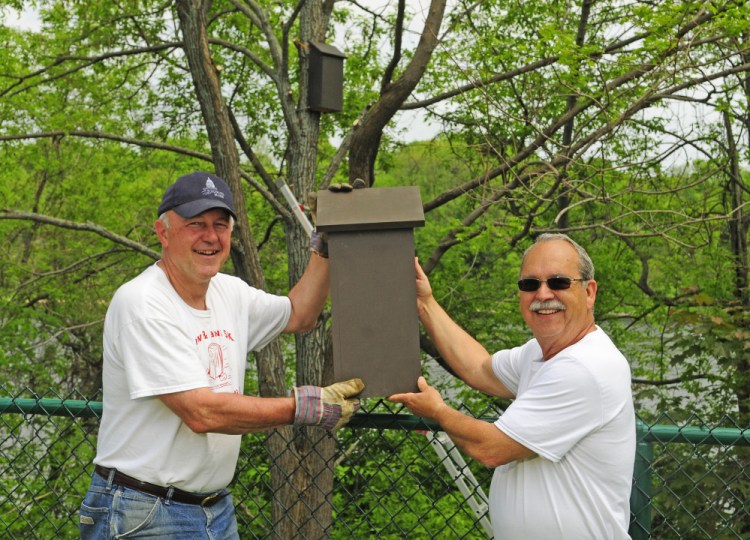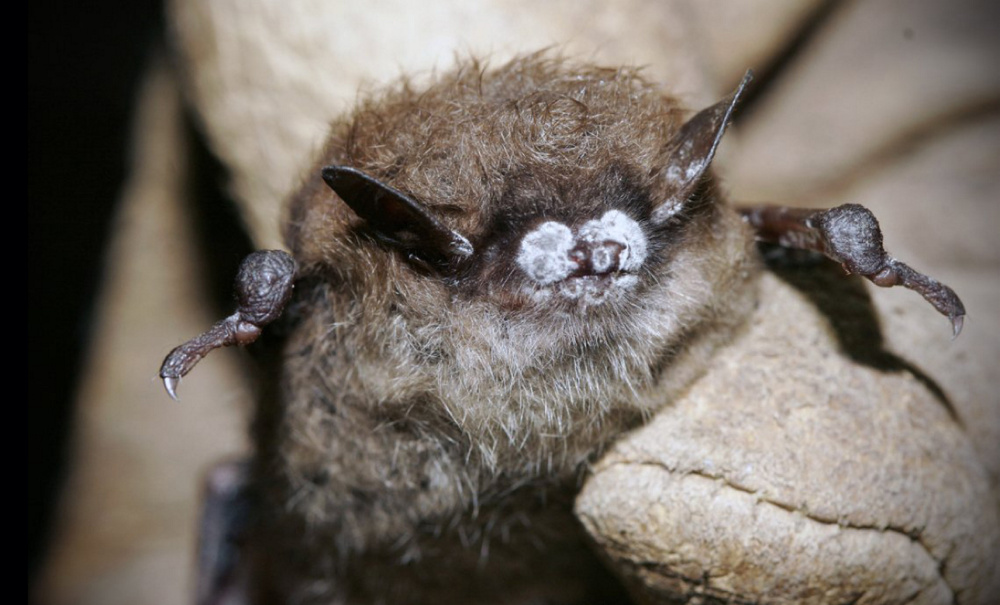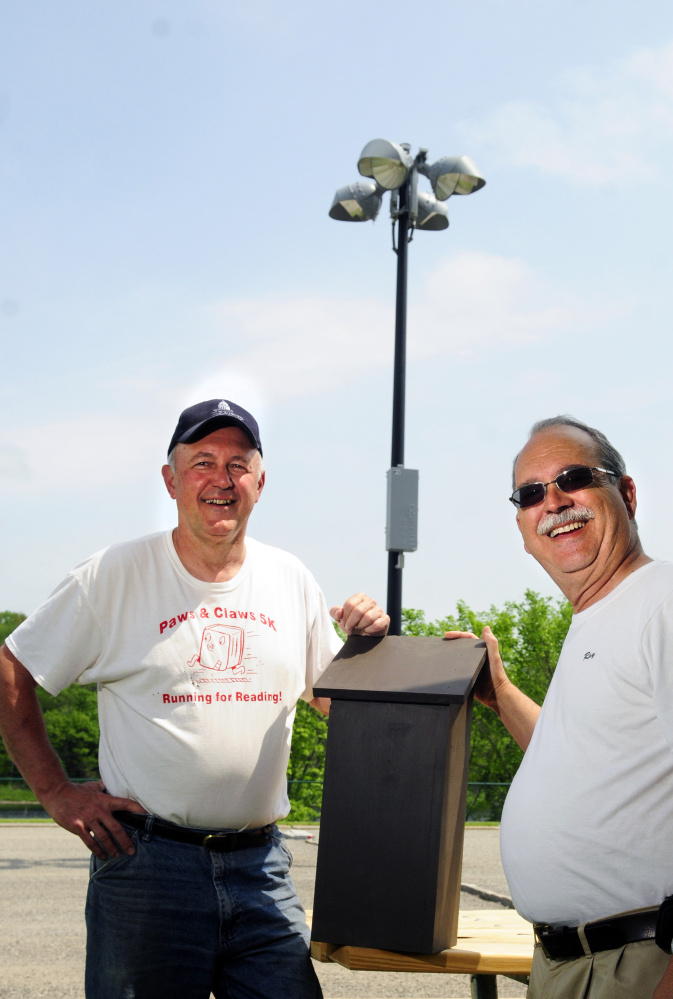AUGUSTA — A federal requirement discovered as part of the permitting process for a new fire station in north Augusta has led, in a roundabout way, to a citywide effort to help bats survive.
The population of bats that hibernate in the winter, of which Maine has five species, has been decimated by white nose syndrome, a disease caused by a fungus that grows in dark places, including those favored by bats for winter hibernation. It has killed more than 1 million bats in the Northeast and, in some hibernation areas, 90 to 100 percent of bats have died.
Their survival is important not just for the bats themselves, but for anyone who doesn’t like mosquitoes and other insects. Insects, including some of the most damaging agricultural pests, make up the diet of bats. Some bats eat their body weight in insects in a single night, up to 1,200 an hour. A single bat can eat 6,000 to 8,000 insects a night.
Recently Augusta firefighters, in their spare time and using their own lumber, built about 35 bat houses to be put up on city property.
Also, next fall students in the carpentry program at the Capital Area Technical Center, as part of their curriculum for the year, will learn to build bat houses, and then put that knowledge to work building still more wooden homes to be put up locally for the insect-devouring winged creatures.
All of this grew out of discussions by city officials about a new federal requirement meant to protect northern long-eared bats, which are listed as threatened under the Endangered Species Act, and other bats affected by the disease.
Because of the new federal rules published early this year, the city had to have the Army Corps of Engineers receive notification from the federal Fish and Wildlife Service that the city’s plans to cut down about a dozen trees for the planned new north Augusta fire station, on a site considered to be bat habitat, would not harm bats, according to City Manager William Bridgeo.
The Fish and Wildlife Service reviewed the site and determined building a fire station there would not harm bats directly, and the project has received its needed permits. Site construction began last week.
The discussion of bats and their struggles with white nose syndrome prompted firefighters to build bat houses, however, and Ward 3 City Councilor Patrick Paradis to champion efforts to help with their survival, at least in Augusta.
“It struck a chord with me and has sort of taken on a life of its own,” Paradis said. “We were going to take down some prime bat habitat. I said, if we’re part of the problem, then why can’t we be part of the solution?”
Paradis contacted school officials, who put him in contact with Jim Holland, director of Capital Area Technical Center.
Holland said starting with the fall semester, building bat houses will be included as part of the course curriculum in the technical center’s carpentry program. This year, when approached by Paradis, students in the program already were committed to other projects and didn’t have time to take on building bat houses.
Holland said building bat houses could be beneficial both to bats and students.
“Most of them are first-year students, and a lot of them really need to learn basic skills — how to use a tape measure, how to cut, had to use hand tools, power tools, and they need to learn how to measure and then make cuts,” Holland said. “And a lot of cutting work goes into (building a bat house), and that will help our students.”
Paradis said he also hopes elementary school students will get involved in the bat project, such as learning about bats in the classroom and helping select spots where bat houses can be placed, and helping put them up.
“We have this natural way to combat insects (with bats), and the fewer insecticides we use and the more we restore balance in nature to take care of these things, the better off we are,” Paradis said. “If students learn that and take that into their adulthood, I’ll feel like I accomplished something with this.”
Paradis said Hammond Lumber agreed to donate lumber for the project.
Cory Mosby, small mammal biologist with the state Department of Inland Fisheries and Wildlife, said white nose syndrome has decimated some species of Maine bats. He said the fungus gets on the faces of hibernating bats. That wakes them up, which wastes energy and fat they had stored up, using it up before they get through the winter.
“They run through their fat stores before the insects come out, and they die of starvation and exposure,” Mosby said.
He said people can help by building bat houses.
Even a small bat house can house up to 60 bats. Larger structures can hold 200, Holland said.
Mosby said if you build a bat house, bats will occupy it about 60 percent of the time.
Also, if Mainers have bats roosting on their property, they can help by taking part in the Maine bat colony identification program, BatME.
The citizen-science project BatME project began in 2015 as a new way to monitor bat populations in the state. Residents who wish to participate may sign up at BatME.org.
Other ways Mainers can help bats, according to state Inland Fisheries and Wildlife officials, include following these recommendations:
• Do not handle live or dead bats.
• If you have bats roosting in domestic structures, allow them to rear their pups and exit the structure at the end of the summer before closing off any entrance holes, and provide bats with a bat house for when they return the following year.
• Do not enter bat caves or mines during the winter hibernation months because it disturbs the bats and causes them to use limited fat reserves.
Numerous online sites provide instructions for building a bat house, including links posted by the U.S. Fish and Wildlife Service and Bat Conservation International.
Sites for bat houses need to be chosen carefully, officials noted. They need full exposure to the sun, to keep the bats warm, and should be stained so they are black or dark brown.
Mosby said bat houses should be mounted at least 12 feet high and can be put on the side of a house or barn, or on a standalone pole. They can be put on trees, but they still need full exposure to the sun, which can be blocked by branches.
Mosby said bats, which can live 30 years or more, can be brought back as a species from the decimation of the disease.
Keith Edwards — 621-5647
Twitter: @kedwardskj
Send questions/comments to the editors.







Success. Please wait for the page to reload. If the page does not reload within 5 seconds, please refresh the page.
Enter your email and password to access comments.
Hi, to comment on stories you must . This profile is in addition to your subscription and website login.
Already have a commenting profile? .
Invalid username/password.
Please check your email to confirm and complete your registration.
Only subscribers are eligible to post comments. Please subscribe or login first for digital access. Here’s why.
Use the form below to reset your password. When you've submitted your account email, we will send an email with a reset code.